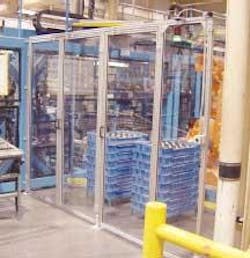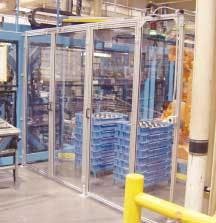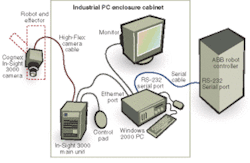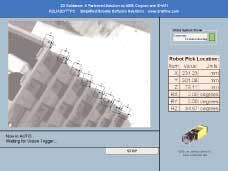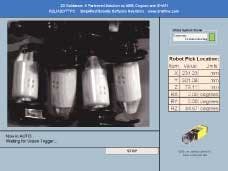Robots/vision add flexibility to auto-part manufacturing
Layered bin picking uses robots, cameras, computers, and software to increase the productivity in factory-floor environments.
By Andrew Wilson, Editor
In the past, OEM suppliers to automotive manufacturers such as General Motors, Ford, and DaimlerChrysler have remained competitive by automating the manufacture of their products using custom systems. By doing so, the manufacturers of pistons, engines, tires, and gas tanks have reduced labor costs and operator error and, at the same time, increased productivity, reliability, and product quality.
Using a mixture of custom and off-the-shelf bowl feeders, conveyor belts, fixtured robots, and machine-vision inspection systems, automated production lines are specifically tailored to meet the demands of manufacturing a specific product rapidly. Although such systems may prove cost-effective for large production runs, they must often be re-engineered when a new product is specified or when a specific part needs to be produced in relatively small batches. "This expensive retailoring of automated assembly lines," says Adil Shafi, president of Shafi Inc., "demands that more flexible automation systems be deployed—those that can easily be adapted, allowing production lines to be inexpensively and quickly retailored."
FUEL SHUT OFF
VITEC LLC, an automotive supplier, recognized this need when specifying an automated assembly line. After preforming plastic tanks, the company must add a number of fuel valves, nozzles, and pipes, including a fill-level vent valve (FLVV), before final shipping to a manufacturer. "In the past," says Shafi, "operators would manually load each FLVV into a fixture at a plastic-welding station. The part would then be welded to the tank and moved along the production line to the next stage. This required one operator per shift, was prone to human error and fatigue, and, VITEC determined, was not cost-effective for two-shift-per-day production."
To automate the process, VITEC turned to Shafi to develop a flexible layered-bin picking system that uses vision-based robotics. Layered-bin picking is a parts-handling method that does not require conveyors, lift-and-locate mechanisms, custom in-feeders, or pallets. Instead, FLVVs are presented to the system in a random position and orientation within stacks of inexpensive trays (which can accommodate virtually any part with roughly the same size) and placed by the robot in the fixture, without operator intervention (see Fig. 1).
On each shift, an operator fills four stacks of eight trays with the parts and places them in two cells on either side of a robot, a task that takes approximately 30 minutes. "Each side can accommodate 384 parts—enough for four hours of unattended operation," says Shafi.
After the trays are loaded into the workcell, parts must be automatically retrieved, inspected, and placed in the welding fixture. To accomplish this, Shafi integrated a Cognex In-Sight 3000 machine-vision system with an ABB IRB-4400 robot. Under control of a PC-based host, the output from the In-Sight 3000 camera is digitized by the In-Sight 3000 control unit and communicated to the host over Ethernet (see Fig. 2).
To properly compute the location of each part, the system must first compute the height of the stack of trays. After the robot moves over the known maximum working height of the tray, the In-Sight 3000 camera mounted in the head captures images of the stack of trays (see Fig. 3). By determining the edge locations of each of the trays, the number of trays can be computed and the height of the stacked trays determined. This is an angled 3-D approach that uses a single camera.
"This requires the use of only a single camera in the system," says Shafi, "and allows us to use Cognex In-Sight vision tools to compute the 3-D depth of the stack." After the height is computed, FLVVs within each tray are located using the same camera.
To properly pick the FLVV from the tray, the body of each part (which is not lying flat, but is easier to image) is first located and its position transmitted to an ABB robot controller over an RS-232 port. Using dual suction cups attached to the robot, each part is then picked from the tray and placed in a "toss-fixture" or nest (see Fig. 4). Before each part can be placed into the welding machine for attachment to the gas tank, it must be inspected. When the part is properly positioned in the fixture, the camera is oriented above the fixture, and an image of the part is captured by the In-Sight camera.
The image helps determine the precise angular orientation of the part and is compared with known good parts to establish if the correct FLVV had originally been loaded into the tray. A pattern-matching approach is used here. The stem orientation of the part is also determined at this point for a precise parallel jaw grip (located on the same end effector).
The part is then picked from the fixture by a parallel jaw mechanism on the robot, turned upside down, and loaded into the welding machine. After this loading is complete, the robot returns to the tray to pick the next part. At this stage, the camera once again determines the position and location of parts in the tray. If no parts remain in the tray, the robot uses a large suction cup (also on the same end effector) to transfer the tray to empty tray stacks located at two locations at either side behind the robot. After the next stack is exposed for picking, the cycle is repeated.
SOFTWARE SOLUTIONS
"In developing the system," says Shafi, "it was necessary to integrate vision and robotic control functions with our Reliabot software. To perform functions such as mapping the vision-based coordinate system with real-world robot coordinates, the Reliabot software seamlessly integrates underlying software from Cognex and ABB (along with 10 other robot platforms) to transfer and compute data between the vision system and robot. The software is easy to use for operators and allows developers to set up specific system peripherals such as cameras, robot controllers and robots using a menu-driven wizard.
A simple user interface in Reliabot (developed in Microsoft Visual Basic) allows operators to monitor the status of the In-Sight system. The PC control system transmits the part location to the ABB robot and allows the vision system to be monitored from the PC screen (see Fig. 5). By transferring captured images over the In-Sight Ethernet port," says Shafi, "it is possible to present the user with an interface that can not only show the images as they are captured from the vision system but other parameters such as the angle of the FLVV in the part fixture." In this way, the user can dynamically visualize the operation of the system as it is working.
"In the past," says Shafi, "many end users were presented with systems that could not perform the task required." Because of this, many users are still skeptical of the capabilities of flexible automtion systems.
To overcome this reticence, many companies, including Shafi, are building presale demonstration units that show the customer how such systems can perform specific tasks. This approach eliminates or manages the risk up front in projects prior to contractual commitments. It protects the purchaser and supplier. "Once such systems are built, the customer is reassured that the investment will prove worthwhile in real-world conditions," he says.
Company Info
ABB Flexible Automation, Auburn Hills, MI, USA www.abb.com
Cognex, Natick, MA, USA www.cognex.com
Shafi Inc., Brighton, MI,USA www.shafiinc.com
VITEC LLC, Detroit, MI, USA www.vitec-usa.com
